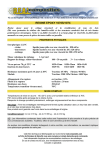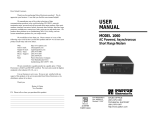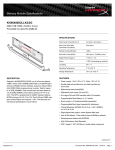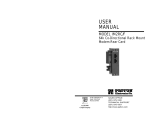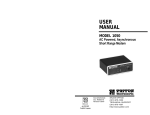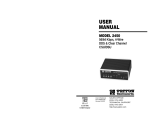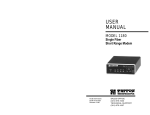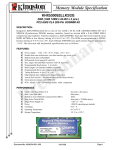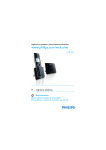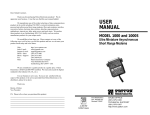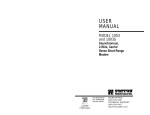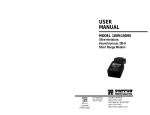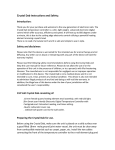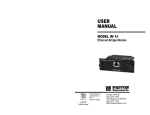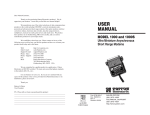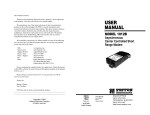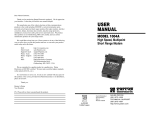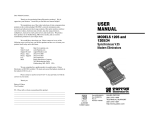Download USER MANUAL
Transcript
Dear Valued Customer, Thank you for purchasing Patton Electronics products! We do appreciate your business. I trust that you find this user manual helpful. We manufacture one of the widest selections of data communications products in the world including CSU/DSU's, network termination units, powered and self-powered short range modems, fiber optic modems, interface converters, baluns, electronic data switches, data-line surge protectors, multiplexers, transceivers, hubs, print servers and much more. We produce these products at our Gaithersburg, MD, USA, facility, and can custom manufacture products for your unique needs. USER MANUAL We would like to hear from you. Please contact us in any of the following ways to tell us how you like this product and how we can meet your product needs today and in the future. Web: Sales E-mail: Support E-mail: Phone - Sales Phone - Support Fax: Mail: MODEL 1070 AC Powered, Synchronous Short Range Modem http://www.patton.com [email protected] [email protected] (301) 975-1000 (301) 975-1007 (301) 869-9293 Patton Electronics Company 7622 Rickenbacker Drive Gaithersburg, MD 20879 USA We are committed to a quality product at a quality price. Patton Electronics is ISO 9001 certified. We meet and exceed the highest standards in the industry (CE, UL, etc.). It is our business to serve you. If you are not satisfied with any aspect of this product or the service provided from Patton Electronics or its distributors, please let us know. Thank you. Burton A.Patton Vice President P.S. Please tell us where you purchased this product. _______________________________________________________________ _______________________________________________________________ _______________________________________________________________ _______________________________________________________________ _______________________________________________________________ _______________________________________________________________ _______________________________________________________________ CERTIFIED Copyright © 1997 Patton Electronics Company All Rights Reserved An ISO-9001 Certified Company Part #07M1070-C Doc. #067011U, Rev. D Revised 1/22/08 SALES OFFICE (301) 975-1000 TECHNICAL SUPPORT (301) 975-1007 http://www.patton.com 1.0 WARRANTY INFORMATION 1.3 SERVICE Patton Electronics warrants all Model 1070 components to be free from defects, and will—at our option—repair or replace the product should it fail within one year from the first date of shipment. This warranty is limited to defects in workmanship or materials, and does not cover customer damage, abuse or unauthorized modification. If this product fails or does not perform as warranted, your sole recourse shall be repair or replacement as described above. Under no condition shall Patton Electronics be liable for any damages incurred by the use of this product. These damages include, but are not limited to, the following: lost profits, lost savings and incidental or consequential damages arising from the use of or inability to use this product. Patton Electronics specifically disclaims all other warranties, expressed or implied, and the installation or use of this product shall be deemed an acceptance of these terms by the user. All warranty and non-warranty repairs must be returned freight prepaid and insured to Patton Electronics. All returns must have a Return Materials Authorization number on the outside of the shipping container. This number may be obtained from Patton Electronics Technical Service at (301) 975-1007, http://www.patton.com, or [email protected]. NOTE: Packages received without an RMA number will not be accepted. Patton Electronics' technical staff is also available to answer any questions that might arise concerning the installation or use of your Model 1070. Technical Service hours: 8AM to 5PM EST, Monday through Friday. 1.1 RADIO AND TV INTERFERENCE The Model 1070 generates and uses radio frequency energy, and if not installed and used properly—that is, in strict accordance with the manufacturer's instructions—may cause interference to radio and television reception. The Model 1070 has been tested and found to comply with the limits for a Class A computing device in accordance with the specifications in Subpart J of Part 15 of FCC rules, which are designed to provide reasonable protection from such interference in a commercial installation. However, there is no guarantee that interference will not occur in a particular installation. If the Model 1070 does cause interference to radio or television reception, which can be determined by disconnecting the RS-232 interface, the user is encouraged to try to correct the interference by one or more of the following measures: moving the computing equipment away from the receiver, re-orienting the receiving antenna and/or plugging the receiving equipment into a different AC outlet (such that the computing equipment and receiver are on different branches). 1.2 CE NOTICE The CE symbol on your Patton Electronics equipment indicates that it is in compliance with the Electromagnetic Compatibility (EMC) directive and the Low Voltage Directive (LVD) of the Union European (EU). A Certificate of Compliance is available by contacting Technical Support. 1 2 1.0 WARRANTY INFORMATION 1.3 SERVICE Patton Electronics warrants all Model 1070 components to be free from defects, and will—at our option—repair or replace the product should it fail within one year from the first date of shipment. This warranty is limited to defects in workmanship or materials, and does not cover customer damage, abuse or unauthorized modification. If this product fails or does not perform as warranted, your sole recourse shall be repair or replacement as described above. Under no condition shall Patton Electronics be liable for any damages incurred by the use of this product. These damages include, but are not limited to, the following: lost profits, lost savings and incidental or consequential damages arising from the use of or inability to use this product. Patton Electronics specifically disclaims all other warranties, expressed or implied, and the installation or use of this product shall be deemed an acceptance of these terms by the user. All warranty and non-warranty repairs must be returned freight prepaid and insured to Patton Electronics. All returns must have a Return Materials Authorization number on the outside of the shipping container. This number may be obtained from Patton Electronics Technical Service at (301) 975-1007, http://www.patton.com, or [email protected]. NOTE: Packages received without an RMA number will not be accepted. Patton Electronics' technical staff is also available to answer any questions that might arise concerning the installation or use of your Model 1070. Technical Service hours: 8AM to 5PM EST, Monday through Friday. 1.1 RADIO AND TV INTERFERENCE The Model 1070 generates and uses radio frequency energy, and if not installed and used properly—that is, in strict accordance with the manufacturer's instructions—may cause interference to radio and television reception. The Model 1070 has been tested and found to comply with the limits for a Class A computing device in accordance with the specifications in Subpart J of Part 15 of FCC rules, which are designed to provide reasonable protection from such interference in a commercial installation. However, there is no guarantee that interference will not occur in a particular installation. If the Model 1070 does cause interference to radio or television reception, which can be determined by disconnecting the RS-232 interface, the user is encouraged to try to correct the interference by one or more of the following measures: moving the computing equipment away from the receiver, re-orienting the receiving antenna and/or plugging the receiving equipment into a different AC outlet (such that the computing equipment and receiver are on different branches). 1.2 CE NOTICE The CE symbol on your Patton Electronics equipment indicates that it is in compliance with the Electromagnetic Compatibility (EMC) directive and the Low Voltage Directive (LVD) of the Union European (EU). A Certificate of Compliance is available by contacting Technical Support. 1 2 2.0 GENERAL INFORMATION 3.0 CONFIGURATION Thank you for your purchase of this Patton Electronics product. This product has been thoroughly inspected and tested and is warranted for One Year parts and labor. If any questions or problems arise during installation or use of this product, please do not hesitate to contact Patton Electronics Technical Support at (301) 975-1007. The Model 1070 uses a set of eight external DIP switches that allow configuration to a wide range of synchronous applications. Because all eight switches are in one externally accessible DIP package, there is no need to open the Model 1070's case for configuration. The switches allow you to control line contention, clocking methods, RTS/CTS delay and data rates. Figures 1 and 2 (below) and Table 1 (opposite page) summarize the switch locations, positions and functions. 2.1 FEATURES Data rates from 1.2 to 19.2 Kbps, switch selectable Built-in optical isolation & high speed surge protection Distances up to 10 miles Tristate LED indicators Point-to-point or multipoint Loopback test modes Internal or external clocking Hardware and software flow control support Externally powered 6 7 8 FRONT 2 3 4 5 • • • • • • • • • The Model 1070 Series synchronous short range modem is equipped with a virtual wish list of “bells and whistles”: Point-to-point or multipoint applications are supported. Two separate control signals may be passed (one each way): RTS and DCD. Data lines are protected from ground loops and electrically volatile environments by optical isolation and Silicon Avalanche Diodes. System integrity can be evaluated using two test modes: local analog loopback and remote analog loopback. Tri-state LEDs monitor transmit data, receive data and control signals. Finally, 4-wire connections may be made using either an RJ-11 jack or terminal blocks—both are included. In addition, the Model 1070 is perfect for low power RS-232 applications. The new Model 1070 is AC powered and recommended for low power RS-232 environments. The Model 1070 supports switch selectable data rates to 19.2 Kbps, and extends RS-232 transmission distances up to 10 miles over two twisted pair. 1 ON 2.2 DESCRIPTION REAR Figure 1. Switch locations underneath Model 1070 ON ON 1 2 3 4 5 6 8 OFF Figure 2. Close up of 1070 DIP switch package showing OFF/ON positions relative to switch numbers The Model 1070 is housed in a sturdy metal case, and comes with either 115 or 220V external transformers. This is the top-of-the-line in synchronous short range modems. 3 7 4 2.0 GENERAL INFORMATION 3.0 CONFIGURATION Thank you for your purchase of this Patton Electronics product. This product has been thoroughly inspected and tested and is warranted for One Year parts and labor. If any questions or problems arise during installation or use of this product, please do not hesitate to contact Patton Electronics Technical Support at (301) 975-1007. The Model 1070 uses a set of eight external DIP switches that allow configuration to a wide range of synchronous applications. Because all eight switches are in one externally accessible DIP package, there is no need to open the Model 1070's case for configuration. The switches allow you to control line contention, clocking methods, RTS/CTS delay and data rates. Figures 1 and 2 (below) and Table 1 (opposite page) summarize the switch locations, positions and functions. 2.1 FEATURES Data rates from 1.2 to 19.2 Kbps, switch selectable Built-in optical isolation & high speed surge protection Distances up to 10 miles Tristate LED indicators Point-to-point or multipoint Loopback test modes Internal or external clocking Hardware and software flow control support Externally powered 6 7 8 FRONT 2 3 4 5 • • • • • • • • • The Model 1070 Series synchronous short range modem is equipped with a virtual wish list of “bells and whistles”: Point-to-point or multipoint applications are supported. Two separate control signals may be passed (one each way): RTS and DCD. Data lines are protected from ground loops and electrically volatile environments by optical isolation and Silicon Avalanche Diodes. System integrity can be evaluated using two test modes: local analog loopback and remote analog loopback. Tri-state LEDs monitor transmit data, receive data and control signals. Finally, 4-wire connections may be made using either an RJ-11 jack or terminal blocks—both are included. In addition, the Model 1070 is perfect for low power RS-232 applications. The new Model 1070 is AC powered and recommended for low power RS-232 environments. The Model 1070 supports switch selectable data rates to 19.2 Kbps, and extends RS-232 transmission distances up to 10 miles over two twisted pair. 1 ON 2.2 DESCRIPTION REAR Figure 1. Switch locations underneath Model 1070 ON ON 1 2 3 4 5 6 8 OFF Figure 2. Close up of 1070 DIP switch package showing OFF/ON positions relative to switch numbers The Model 1070 is housed in a sturdy metal case, and comes with either 115 or 220V external transformers. This is the top-of-the-line in synchronous short range modems. 3 7 4 3.1.2 TRANSMIT CLOCK SWITCH SUMMARY TABLE Position Function Factory Default Switch 1 Data Rate Off Switch 2 Data Rate Off Switch 3 Data Rate On Switch 4 Not Used N/A Switch 5 Transmit Clock Off Switch 6 RTS/CTS Delay On Switch 7 RTS/CTS Delay Off Switch 8 Carrier Control Off } Switch 5 is used to specify the clocking method. The Model 1070 can provide an internal clock (Pin 15), or receive an external clock (from Pin 24). 9,600 Bps Switch 5 On = Off = External Internal Internal Clock } 8 ms Constant Table 1. Summary of switch settings, showing factory defaults 3.1.3 RTS/CTS DELAY Switches 6 and 7 are used together to specify RTS/CTS delay. After request to send (RTS) is raised by the host terminal, the Model 1070 raises CTS after a slight delay in order to give the remote terminal time to receive an incoming signal. Depending on the type of environment, either a 0 mS, 8 mS or 53 mS delay can be selected. 3.1 DETAILED SWITCH SETTINGS This section provides detailed information about the function of each DIP switch and lists all possible settings. Use this section as configuration guide for applications where the Model 1070's default would not provide correct results. Switch 6 On On Off Switch 7 On = Off = On = 0 mS 8 mS 53 mS 3.1.4 CARRIER ENABLE 3.1.1 DATA RATE Switches 1 thru 3 are set in combination to allow the Model 1070 to be used at data rates from 1200 bps up to 19,200 bps. Switch 1 On Off On On Off Off On Off Switch 2 On On Off On Off On Off Off Switch 3 On On On Off On Off Off Off Setting 1.2 Kbps 2.4 Kbps 4.8 Kbps 7.2 Kbps 9.6 Kbps 14.4 Kbps 19.2 Kbps 19.2 Kbps Switch 8 is used to specify how the carrier signal is raised. In most point-to-point full duplex applications, the carrier signal can remain constantly "high". In a multi-point environment, contention for the line is "controlled" by RTS. Switch 8 On = Off = Controlled by RTS Constant Carrier Note: Switch 4 is not used. 5 6 3.1.2 TRANSMIT CLOCK SWITCH SUMMARY TABLE Position Function Factory Default Switch 1 Data Rate Off Switch 2 Data Rate Off Switch 3 Data Rate On Switch 4 Not Used N/A Switch 5 Transmit Clock Off Switch 6 RTS/CTS Delay On Switch 7 RTS/CTS Delay Off Switch 8 Carrier Control Off } Switch 5 is used to specify the clocking method. The Model 1070 can provide an internal clock (Pin 15), or receive an external clock (from Pin 24). 9,600 Bps Switch 5 On = Off = External Internal Internal Clock } 8 ms Constant Table 1. Summary of switch settings, showing factory defaults 3.1.3 RTS/CTS DELAY Switches 6 and 7 are used together to specify RTS/CTS delay. After request to send (RTS) is raised by the host terminal, the Model 1070 raises CTS after a slight delay in order to give the remote terminal time to receive an incoming signal. Depending on the type of environment, either a 0 mS, 8 mS or 53 mS delay can be selected. 3.1 DETAILED SWITCH SETTINGS This section provides detailed information about the function of each DIP switch and lists all possible settings. Use this section as configuration guide for applications where the Model 1070's default would not provide correct results. Switch 6 On On Off Switch 7 On = Off = On = 0 mS 8 mS 53 mS 3.1.4 CARRIER ENABLE 3.1.1 DATA RATE Switches 1 thru 3 are set in combination to allow the Model 1070 to be used at data rates from 1200 bps up to 19,200 bps. Switch 1 On Off On On Off Off On Off Switch 2 On On Off On Off On Off Off Switch 3 On On On Off On Off Off Off Setting 1.2 Kbps 2.4 Kbps 4.8 Kbps 7.2 Kbps 9.6 Kbps 14.4 Kbps 19.2 Kbps 19.2 Kbps Switch 8 is used to specify how the carrier signal is raised. In most point-to-point full duplex applications, the carrier signal can remain constantly "high". In a multi-point environment, contention for the line is "controlled" by RTS. Switch 8 On = Off = Controlled by RTS Constant Carrier Note: Switch 4 is not used. 5 6 4.0 INSTALLATION 4.1.2 TWISTED PAIR CONNECTION USING RJ-11 The Model 1070 is easy to install. After configuring the DIP switches and DCE/DTE switches, connect the two twisted pairs using one of two methods: terminal blocks or RJ-11 jack. Figure 3 (below) shows the location of the terminal blocks and RJ-11 jack, as well as the female DB-25 on the rear of the Model 1070. If your two-pair cable is terminated in an RJ-11 plug, you may use the RJ-11 jack in the back of the Model 1070 to make the connection. The RJ-11 jack on a Model 1070 series Short Range Modem is prewired for a standard TELCO wiring environment. To be sure you have the right wiring, use the diagram below as a guide. RJ-11 1 2 3 4 5 6 Made In The USA Powered Async. Short Range Modem RX+ RX- GND TX- TX+ Power Line RS-232 Interface Figure 3. Rear view of 1070 showing interface connectors SIGNAL GND† RCV XMT XMT RCV GND For proper signal crossing between two Model 1070s using RJ-11 connectors, pin-out the twisted pair cable according to the diagram below. The Model 1070 is not sensitive to polarity, so other configurations may work. 4.1 TWISTED PAIR WIRING OVERVIEW These short range modems are designed to work in pairs. You will need one at each end of a 4-wire twisted pair circuit. The pairs must be "dry" (unconditioned) metallic wire, 19 - 26 AWG. The smaller gauges limit distance somewhat compared with larger gauges. When you have completed wiring for your data circuit, the pin connections should be as shown below: SIGNAL PIN# COLOR‡ COLOR PIN# SIGNAL GND† RCV XMT XMT RCV GND 1 2 3 4 5 6 Blue Yellow Green Red Black White White Red Black Yellow Green Blue GND XMT RCV RCV XMT GND Connection to ground is optional Standard color codes—yours may be different † XMT XMT G RCV RCV To Shield (Optional) RCV RCV G XMT XMT ‡ } One Pair } One Pair 4.1.1 TWISTED PAIR CONNECTION USING TERMINAL BLOCKS 1 - Blue 2 - Yellow 3 - Green 4 - Red 5 - Black 6 - White AT&T standard modular color codes If your two twisted pair line terminates in bare wires, strip the ends and connect the individual leads to each Model 1070's terminal block. Be sure the end-to-end connections follow the diagram above. 7 8 6 4 5 2 3 1 4.0 INSTALLATION 4.1.2 TWISTED PAIR CONNECTION USING RJ-11 The Model 1070 is easy to install. After configuring the DIP switches and DCE/DTE switches, connect the two twisted pairs using one of two methods: terminal blocks or RJ-11 jack. Figure 3 (below) shows the location of the terminal blocks and RJ-11 jack, as well as the female DB-25 on the rear of the Model 1070. If your two-pair cable is terminated in an RJ-11 plug, you may use the RJ-11 jack in the back of the Model 1070 to make the connection. The RJ-11 jack on a Model 1070 series Short Range Modem is prewired for a standard TELCO wiring environment. To be sure you have the right wiring, use the diagram below as a guide. RJ-11 1 2 3 4 5 6 Made In The USA Powered Async. Short Range Modem RX+ RX- GND TX- TX+ Power Line RS-232 Interface Figure 3. Rear view of 1070 showing interface connectors SIGNAL GND† RCV XMT XMT RCV GND For proper signal crossing between two Model 1070s using RJ-11 connectors, pin-out the twisted pair cable according to the diagram below. The Model 1070 is not sensitive to polarity, so other configurations may work. 4.1 TWISTED PAIR WIRING OVERVIEW These short range modems are designed to work in pairs. You will need one at each end of a 4-wire twisted pair circuit. The pairs must be "dry" (unconditioned) metallic wire, 19 - 26 AWG. The smaller gauges limit distance somewhat compared with larger gauges. When you have completed wiring for your data circuit, the pin connections should be as shown below: SIGNAL PIN# COLOR‡ COLOR PIN# SIGNAL GND† RCV XMT XMT RCV GND 1 2 3 4 5 6 Blue Yellow Green Red Black White White Red Black Yellow Green Blue GND XMT RCV RCV XMT GND Connection to ground is optional Standard color codes—yours may be different † XMT XMT G RCV RCV To Shield (Optional) RCV RCV G XMT XMT ‡ } One Pair } One Pair 4.1.1 TWISTED PAIR CONNECTION USING TERMINAL BLOCKS 1 - Blue 2 - Yellow 3 - Green 4 - Red 5 - Black 6 - White AT&T standard modular color codes If your two twisted pair line terminates in bare wires, strip the ends and connect the individual leads to each Model 1070's terminal block. Be sure the end-to-end connections follow the diagram above. 7 8 6 4 5 2 3 1 4.2 WIRING FOR MULTIPOINT CIRCUITS 4.2.2 STAR TOPOLOGY The Model 1070 supports multi-point applications using either a star or daisy chain topology. Both topologies require special wiring, as well as specific DIP switch settings for master and slave units. In a star topology, you may connect several Model 1070s together in a master/slave arrangement. Maximum distance between the units will vary based upon the number of drops, data rate, wire gauge, etc. Call Patton Technical Support for specific distance estimates. 4.2.1 DAISY CHAIN TOPOLOGY Figure 5 (below) shows how to wire the two-pair cables properly for a Model 1070 star topology. Note that the ground connection is not needed. Using a daisy chain topology, you may connect several Model 1070s together in a master/slave arrangement. Maximum distance between the units will vary based upon the number of drops, data rate, wire gauge, etc. Call Patton Technical Support for specific distance estimates. Figure 4 (below) shows how to wire the two-pair cables properly for a Model 1070 daisy chain topology. Note that the ground connection is not needed. HOST FIRST SLAVE HOST FIRST SLAVE XMT RCV RCV XMT RCV RCV OTHER SLAVE(S) RCV XMT XMT RCV RCV RCV RCV XMT XMT RCV RCV XMT XMT In a multipoint topology, you must configure the CARRIER ENABLE switch (DIP switch 8) differently for the master Model 1070 than for the slave Model 1070(s). Here are the proper DIP switch settings for a daisy chain topology: RCV XMT XMT Figure 5. Model 1070 star wiring In a multipoint topology, you must configure the CARRIER ENABLE switch (DIP switch 8) differently for the master Model 1070 than for the slave Model 1070(s). Here are the proper DIP switch settings for a star topology: Switch Number Master Positions Slave Positions 8 OFF ON XMT XMT Figure 4. Model 1070 daisy chain wiring Switch Number Master Positions Slave Positions SECOND SLAVE 8 OFF ON 4.2 RS-232 CONNECTION To connect the Model 1070 to data terminal hardware (PC, host, terminal, etc.), use a straight through RS-232 cable. To connect the Model 1070 to data communications hardware (modem, multiplexer, etc.), use a null modem RS-232 cable. 9 10 4.2 WIRING FOR MULTIPOINT CIRCUITS 4.2.2 STAR TOPOLOGY The Model 1070 supports multi-point applications using either a star or daisy chain topology. Both topologies require special wiring, as well as specific DIP switch settings for master and slave units. In a star topology, you may connect several Model 1070s together in a master/slave arrangement. Maximum distance between the units will vary based upon the number of drops, data rate, wire gauge, etc. Call Patton Technical Support for specific distance estimates. 4.2.1 DAISY CHAIN TOPOLOGY Figure 5 (below) shows how to wire the two-pair cables properly for a Model 1070 star topology. Note that the ground connection is not needed. Using a daisy chain topology, you may connect several Model 1070s together in a master/slave arrangement. Maximum distance between the units will vary based upon the number of drops, data rate, wire gauge, etc. Call Patton Technical Support for specific distance estimates. Figure 4 (below) shows how to wire the two-pair cables properly for a Model 1070 daisy chain topology. Note that the ground connection is not needed. HOST FIRST SLAVE HOST FIRST SLAVE XMT RCV RCV XMT RCV RCV OTHER SLAVE(S) RCV XMT XMT RCV RCV RCV RCV XMT XMT RCV RCV XMT XMT In a multipoint topology, you must configure the CARRIER ENABLE switch (DIP switch 8) differently for the master Model 1070 than for the slave Model 1070(s). Here are the proper DIP switch settings for a daisy chain topology: RCV XMT XMT Figure 5. Model 1070 star wiring In a multipoint topology, you must configure the CARRIER ENABLE switch (DIP switch 8) differently for the master Model 1070 than for the slave Model 1070(s). Here are the proper DIP switch settings for a star topology: Switch Number Master Positions Slave Positions 8 OFF ON XMT XMT Figure 4. Model 1070 daisy chain wiring Switch Number Master Positions Slave Positions SECOND SLAVE 8 OFF ON 4.2 RS-232 CONNECTION To connect the Model 1070 to data terminal hardware (PC, host, terminal, etc.), use a straight through RS-232 cable. To connect the Model 1070 to data communications hardware (modem, multiplexer, etc.), use a null modem RS-232 cable. 9 10 5.0 OPERATION 5.2.2 REMOTE ANALOG LOOP Once you have properly configured and connected each Model 1070, simply plug in the AC power adapter to get them running; there is no power switch on the Model 1070. You can monitor the operation of the Model 1070 using the front panel LED indicators and built-in loopback test modes. 5.1 LED INDICATORS The Model 1070 incorporates six front panel LEDs that show the status of the modem: The second test mode is Remote Analog Loop. To enter this mode, set one of the Model 1070s (local) in test mode by depressing the "Loopback Test" switch. Any characters sent from the remote Model 1070 will be returned back to the originating device (see Figure 6). If no characters are echoed back, check the wiring between the two Model 1070s. Be sure to wire the units according to the instructions in Section 4.0 Installation. TX+ RX+ TD TX- RX- RX- TX- RD RX+ TX+ 1. The power LED glows when AC power is applied to the modem. 2. The loopback test LED glows when the loopback test switch has been depressed and is in a test mode. 3. The tri-state TD and RD indicators blink red and green with data activity. Solid red indicates a low RS-232 logic level, and no color indicates no activity on the line. Note: RS-232 devices idle in a low state, so the LED will glow red if the connections are correct and the RS-232 device is in an idle state. 4. The RTS and CD indicators glow red for a "low" signal and green for a "high" signal. Note: RTS refers to the signal generated by the DTE on pin 4. CD refers to the signal generated by the Model 1070 on pin 8. It also indicates that a signal is being received by the remote modem. Local 1070 Local 1070RC In Normal Mode In Normal Mode TD Remote1070RC 1070 Remote In Normal Mode TX+ RX+ TD TX- RX- RX- TX- RD RX+ TX+ Local1070RC 1070 Local In Loopback Mode Remote1070RC 1070 Remote In Normal Mode Mode Figure 6. Loopback Test Modes 5.2 LOOPBACK TEST MODES Selected the test modes by depressing the "Loopback Test" switch. When in loopback mode, the "Loopback Test" LED will glow red. Two tests are possible using this switch: Local Analog Loop (LAL) and Remote Analog Loop (RAL). 5.2.1 LOCAL ANALOG LOOP The first test mode is Local Analog Loop (V.54 Loop 3). Any data sent to the local Model 1070 in the this mode will be echoed (returned) back to the user device. For example, characters typed on the keyboard of a terminal will appear on the terminal screen (see Figure 6 on the following page). 11 RD 12 RD TD 5.0 OPERATION 5.2.2 REMOTE ANALOG LOOP Once you have properly configured and connected each Model 1070, simply plug in the AC power adapter to get them running; there is no power switch on the Model 1070. You can monitor the operation of the Model 1070 using the front panel LED indicators and built-in loopback test modes. 5.1 LED INDICATORS The Model 1070 incorporates six front panel LEDs that show the status of the modem: The second test mode is Remote Analog Loop. To enter this mode, set one of the Model 1070s (local) in test mode by depressing the "Loopback Test" switch. Any characters sent from the remote Model 1070 will be returned back to the originating device (see Figure 6). If no characters are echoed back, check the wiring between the two Model 1070s. Be sure to wire the units according to the instructions in Section 4.0 Installation. TX+ RX+ TD TX- RX- RX- TX- RD RX+ TX+ 1. The power LED glows when AC power is applied to the modem. 2. The loopback test LED glows when the loopback test switch has been depressed and is in a test mode. 3. The tri-state TD and RD indicators blink red and green with data activity. Solid red indicates a low RS-232 logic level, and no color indicates no activity on the line. Note: RS-232 devices idle in a low state, so the LED will glow red if the connections are correct and the RS-232 device is in an idle state. 4. The RTS and CD indicators glow red for a "low" signal and green for a "high" signal. Note: RTS refers to the signal generated by the DTE on pin 4. CD refers to the signal generated by the Model 1070 on pin 8. It also indicates that a signal is being received by the remote modem. Local 1070 Local 1070RC In Normal Mode In Normal Mode TD Remote1070RC 1070 Remote In Normal Mode TX+ RX+ TD TX- RX- RX- TX- RD RX+ TX+ Local1070RC 1070 Local In Loopback Mode Remote1070RC 1070 Remote In Normal Mode Mode Figure 6. Loopback Test Modes 5.2 LOOPBACK TEST MODES Selected the test modes by depressing the "Loopback Test" switch. When in loopback mode, the "Loopback Test" LED will glow red. Two tests are possible using this switch: Local Analog Loop (LAL) and Remote Analog Loop (RAL). 5.2.1 LOCAL ANALOG LOOP The first test mode is Local Analog Loop (V.54 Loop 3). Any data sent to the local Model 1070 in the this mode will be echoed (returned) back to the user device. For example, characters typed on the keyboard of a terminal will appear on the terminal screen (see Figure 6 on the following page). 11 RD 12 RD TD APPENDIX A APPENDIX B PATTON MODEL 1070 SPECIFICATIONS PATTON MODEL 1070 CABLE RECOMMENDATIONS Transmission Format: Synchronous The Patton Model 1070 is designed and tested to communicate over twisted-pair cable with the following characteristics: Distances: See table (below) Interface: RS-232 (CCITT V.24) DB-25 female Wire Gauge Capacitance Resistance Transmission Line: 4-wire, unconditioned via RJ-11 or terminal blocks 19 AWG/.9mm 22 AWG/.6mm 24 AWG/.4mm 83nF/mi or 15.72 pF/ft. 83nF/mi or 15.72 pF/ft. 83nF/mi or 15.72 pF/ft. .0163Ω/ft. .0326Ω/ft. .05165Ω/ft. Data Rates: 1.2, 2.4, 4.8, 7.2, 9.6, 14.4 and 19.2 Kbps Clocking: Internal or external Using the above characteristics as a baseline, we estimate the distance limitations for the Model 1070 to be as follows. Controls: Carrier constantly "ON" or controlled by RTS; RTS/CTS delay set to 0, 8 or 53 mS Applications: Point-to-point or multi-point Indicators: Tri-state indicators for Transmit Data, Receive Data, Request to Send and Carrier Detect Diagnostics: Loop 3 and 4, local and remote analog loopback Model 1070 Distance Table - Miles (Km) Data Rate 19,200 9,600 4,800 2,400 1,200 Wire Gauge 19 (.9mm) 22 (.6mm) 2.5 (4.0) 2.1 (3.4) 3.7 (6.0) 2.3 (3.7) 4.9 (7.9) 4.9 (7.9) 8.2 (13.2) 5.8 (9.3) 10.2 (16.4) 8.3 (13.4) 24 (.4mm) 1.3 (2.1) 1.7 (2.7) 2.5 (4.0) 4.6 (7.4) 6.8 (10.9) Optical Isolation: 2500 V RMS (minimum) Power Supply: Wall-mount, 10 - 12V AC, 200mA Dimensions: 4.127"W x 1.52"H x 5.0"L 13 To reduce the potential of difficulties in the field, we recommend that the cable used to connect the Model 1070s have a capacitance of no greater than 20pF/ft., and that the wire be no thinner than 26 AWG. The Model 1070 is designed to withstand normal environmental noise and conditions. However, other environmental factors too numerous to discuss may affect proper operation. The distance table above should be used as a general guideline only. 14 APPENDIX A APPENDIX B PATTON MODEL 1070 SPECIFICATIONS PATTON MODEL 1070 CABLE RECOMMENDATIONS Transmission Format: Synchronous The Patton Model 1070 is designed and tested to communicate over twisted-pair cable with the following characteristics: Distances: See table (below) Interface: RS-232 (CCITT V.24) DB-25 female Wire Gauge Capacitance Resistance Transmission Line: 4-wire, unconditioned via RJ-11 or terminal blocks 19 AWG/.9mm 22 AWG/.6mm 24 AWG/.4mm 83nF/mi or 15.72 pF/ft. 83nF/mi or 15.72 pF/ft. 83nF/mi or 15.72 pF/ft. .0163Ω/ft. .0326Ω/ft. .05165Ω/ft. Data Rates: 1.2, 2.4, 4.8, 7.2, 9.6, 14.4 and 19.2 Kbps Clocking: Internal or external Using the above characteristics as a baseline, we estimate the distance limitations for the Model 1070 to be as follows. Controls: Carrier constantly "ON" or controlled by RTS; RTS/CTS delay set to 0, 8 or 53 mS Applications: Point-to-point or multi-point Indicators: Tri-state indicators for Transmit Data, Receive Data, Request to Send and Carrier Detect Diagnostics: Loop 3 and 4, local and remote analog loopback Model 1070 Distance Table - Miles (Km) Data Rate 19,200 9,600 4,800 2,400 1,200 Wire Gauge 19 (.9mm) 22 (.6mm) 2.5 (4.0) 2.1 (3.4) 3.7 (6.0) 2.3 (3.7) 4.9 (7.9) 4.9 (7.9) 8.2 (13.2) 5.8 (9.3) 10.2 (16.4) 8.3 (13.4) 24 (.4mm) 1.3 (2.1) 1.7 (2.7) 2.5 (4.0) 4.6 (7.4) 6.8 (10.9) Optical Isolation: 2500 V RMS (minimum) Power Supply: Wall-mount, 10 - 12V AC, 200mA Dimensions: 4.127"W x 1.52"H x 5.0"L 13 To reduce the potential of difficulties in the field, we recommend that the cable used to connect the Model 1070s have a capacitance of no greater than 20pF/ft., and that the wire be no thinner than 26 AWG. The Model 1070 is designed to withstand normal environmental noise and conditions. However, other environmental factors too numerous to discuss may affect proper operation. The distance table above should be used as a general guideline only. 14 DIRECTION To Model 1070 APPENDIX C APPENDIX D PATTON MODEL 1070 INTERFACE PIN ASSIGNMENTS PATTON MODEL 1070 BLOCK DIAGRAM STANDARD "DCE" 1- (FG) Frame Ground 2- (TD) Transmit Data 3- (RD) Receive Data 4- (RTS) Request to Send 5- (CTS) Clear to Send 6- (DSR) Data Set Ready 7- (SG) Signal Ground 8- (DCD) Data Carrier Detect Data Term. Ready (DTR) - 20 11- 15 DIRECTION To Model 1070 From Model 1070 To Model 1070 From Model 1070 From Model 1070 From Model 1070 To Model 1070 16 DIRECTION To Model 1070 APPENDIX C APPENDIX D PATTON MODEL 1070 INTERFACE PIN ASSIGNMENTS PATTON MODEL 1070 BLOCK DIAGRAM STANDARD "DCE" 1- (FG) Frame Ground 2- (TD) Transmit Data 3- (RD) Receive Data 4- (RTS) Request to Send 5- (CTS) Clear to Send 6- (DSR) Data Set Ready 7- (SG) Signal Ground 8- (DCD) Data Carrier Detect Data Term. Ready (DTR) - 20 11- 15 DIRECTION To Model 1070 From Model 1070 To Model 1070 From Model 1070 From Model 1070 From Model 1070 To Model 1070 16 APPENDIX B TROUBLESHOOTING SYMPTOM LEDs do not light when AC power transformer is plugged into wall No data transfer in either or both directions PROBLEM APPENDIX B TROUBLESHOOTING SOLUTION 1. Loose power connection 1. Make sure the AC connection is flush 2. Outlet is defective 2. Try a different outlet 3. AC power cord is defective 3. Remove the cord from the outlet and check for continuity 4. The AC transformer is not plugged into the Model 1070 4. Have another cup of coffee! 1. Improper twisted pair wiring 1. Compare your twisted pair wiring with the diagram in Section 4.1 2. Improper bit rate setting 2. Ensure all bit rate settings on all connected serial ports are the same 3. Distance specifications exceeded 17 SYMPTOM PROBLEM SOLUTION 1. Improper RS-232 wiring 1. Check wiring between Model 1070 and connected DTE device—it should be straight through 2. Improper twisted pair wiring 2. Compare your twisted pair wiring with the diagram in Section 4.1 3. Improper bit rate setting 3. Make sure the bit rates on all connected serial devices are the same "TD" and "RD" LEDs indicate activity, but "CD" LED is unlit or red (should be green) 1. Defective twisted pair line 1. Test continuity of twisted pair line 2. Poor twisted pair connection to Model 1070s 2. Check screw terminal/RJ-11 connections to Model 1070s; check integrity of plug RJ-11 terminations Occasional data errors 1. Distance/bit rate capacity exceeded 1. Check specifications in Appendix A 2. Poor quality twisted pair circuit 2. Use a different twisted pair circuit 3. Poor twisted pair connections to Model 1070s 3. Check screw terminal/RJ-11 connections to Model 1070s; check integrity of plug RJ-11 terminations "TD" and "RD" LEDs indicate activity, but units will not communicate or data is garbled 3. Check specifications in Appendix A 18 APPENDIX B TROUBLESHOOTING SYMPTOM LEDs do not light when AC power transformer is plugged into wall No data transfer in either or both directions PROBLEM APPENDIX B TROUBLESHOOTING SOLUTION 1. Loose power connection 1. Make sure the AC connection is flush 2. Outlet is defective 2. Try a different outlet 3. AC power cord is defective 3. Remove the cord from the outlet and check for continuity 4. The AC transformer is not plugged into the Model 1070 4. Have another cup of coffee! 1. Improper twisted pair wiring 1. Compare your twisted pair wiring with the diagram in Section 4.1 2. Improper bit rate setting 2. Ensure all bit rate settings on all connected serial ports are the same 3. Distance specifications exceeded 17 SYMPTOM PROBLEM SOLUTION 1. Improper RS-232 wiring 1. Check wiring between Model 1070 and connected DTE device—it should be straight through 2. Improper twisted pair wiring 2. Compare your twisted pair wiring with the diagram in Section 4.1 3. Improper bit rate setting 3. Make sure the bit rates on all connected serial devices are the same "TD" and "RD" LEDs indicate activity, but "CD" LED is unlit or red (should be green) 1. Defective twisted pair line 1. Test continuity of twisted pair line 2. Poor twisted pair connection to Model 1070s 2. Check screw terminal/RJ-11 connections to Model 1070s; check integrity of plug RJ-11 terminations Occasional data errors 1. Distance/bit rate capacity exceeded 1. Check specifications in Appendix A 2. Poor quality twisted pair circuit 2. Use a different twisted pair circuit 3. Poor twisted pair connections to Model 1070s 3. Check screw terminal/RJ-11 connections to Model 1070s; check integrity of plug RJ-11 terminations "TD" and "RD" LEDs indicate activity, but units will not communicate or data is garbled 3. Check specifications in Appendix A 18 Dear Valued Customer, Thank you for purchasing Patton Electronics products! We do appreciate your business. I trust that you find this user manual helpful. We manufacture one of the widest selections of data communications products in the world including CSU/DSU's, network termination units, powered and self-powered short range modems, fiber optic modems, interface converters, baluns, electronic data switches, data-line surge protectors, multiplexers, transceivers, hubs, print servers and much more. We produce these products at our Gaithersburg, MD, USA, facility, and can custom manufacture products for your unique needs. USER MANUAL We would like to hear from you. Please contact us in any of the following ways to tell us how you like this product and how we can meet your product needs today and in the future. Web: Sales E-mail: Support E-mail: Phone - Sales Phone - Support Fax: Mail: MODEL 1070 AC Powered, Synchronous Short Range Modem http://www.patton.com [email protected] [email protected] (301) 975-1000 (301) 975-1007 (301) 869-9293 Patton Electronics Company 7622 Rickenbacker Drive Gaithersburg, MD 20879 USA We are committed to a quality product at a quality price. Patton Electronics is ISO 9001 certified. We meet and exceed the highest standards in the industry (CE, UL, etc.). It is our business to serve you. If you are not satisfied with any aspect of this product or the service provided from Patton Electronics or its distributors, please let us know. Thank you. Burton A.Patton Vice President P.S. Please tell us where you purchased this product. _______________________________________________________________ _______________________________________________________________ _______________________________________________________________ _______________________________________________________________ _______________________________________________________________ _______________________________________________________________ _______________________________________________________________ CERTIFIED Copyright © 1997 Patton Electronics Company All Rights Reserved An ISO-9001 Certified Company Part #07M1070-C Doc. #067011UC, Rev. D Revised 1/22/08 SALES OFFICE (301) 975-1000 TECHNICAL SUPPORT (301) 975-1007 http://www.patton.com




















